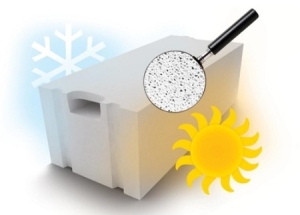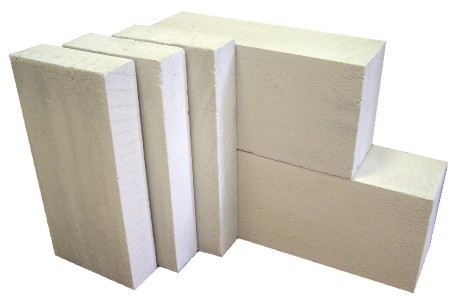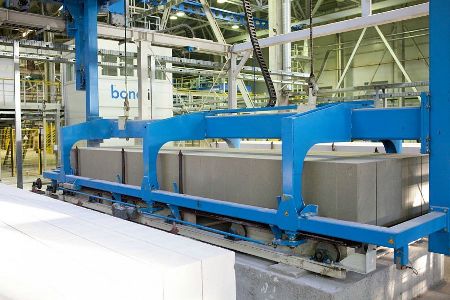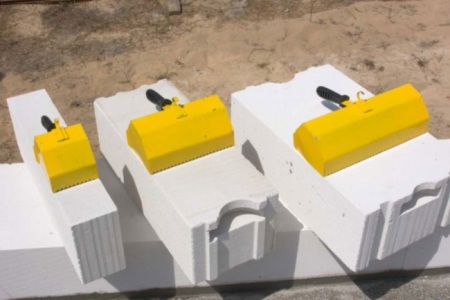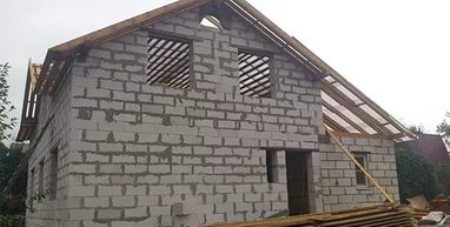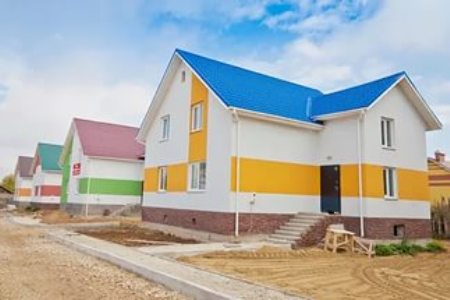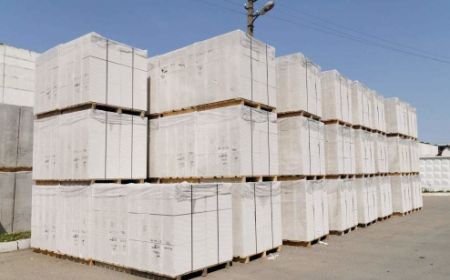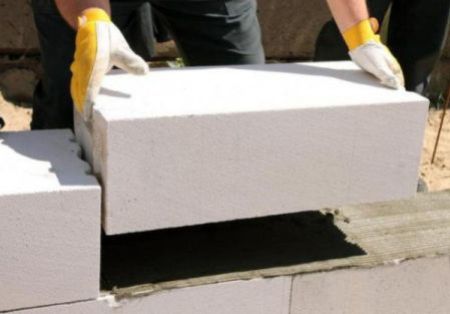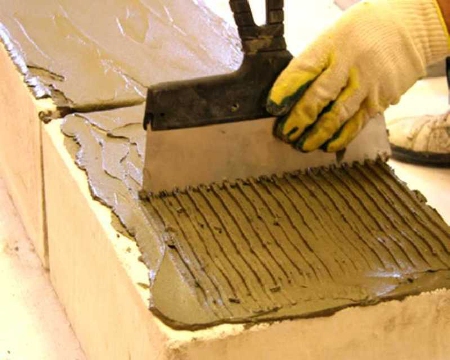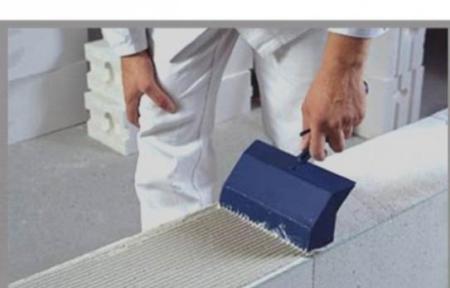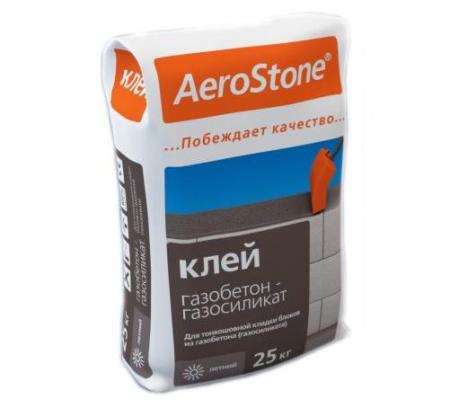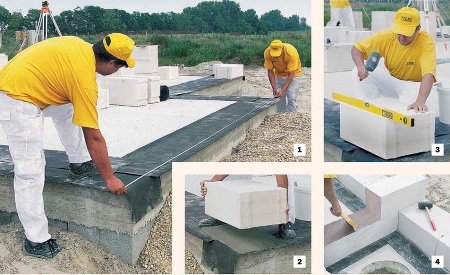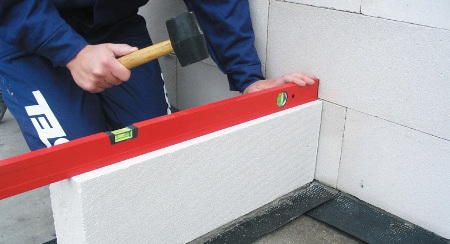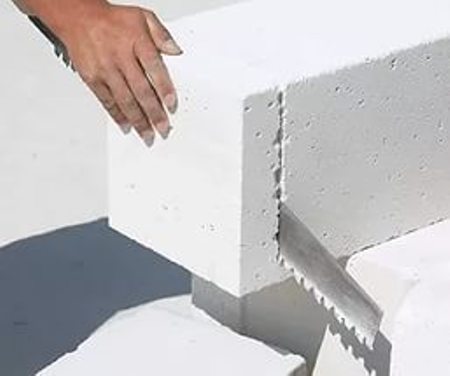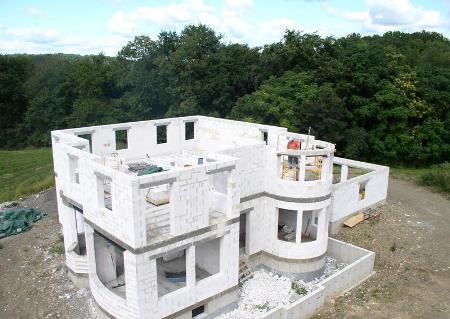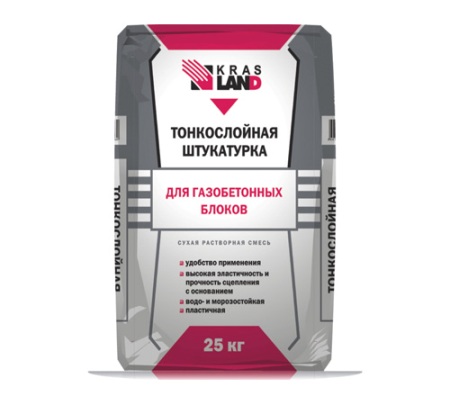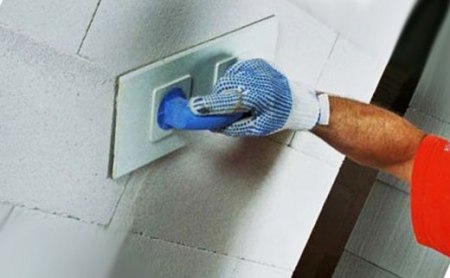Among modern building materials, gas silicate blocks occupy an advantageous place, they attract the attention of professional builders and private developers who, for the sake of economy, perform the laying of the house and utility rooms with their own hands. In fact, being in essence a mineral stone of artificial origin, and possessing its strength properties, the gas silicate blocks are easily stacked, have a relatively low weight, and they can be made with the usual saws for metal.
Content
Manufacture of aerocrete blocks
As we have already mentioned, gas silicate blocks - a material very similar to stone, constructed from them, do not require special conditions for operation.
If we talk about raw materials, which is used in the manufacture of this wall material, it consists of:
- cement
- sand
- lime
- of aluminum powder
The production of cellular blocks is based on the property of lime to react with aluminum powder and to release hydrogen.
Of course, in order for this reaction to take place, certain conditions must be created: the components are mixed in autoclaves, at certain pressure and temperature indices. To adhere to the technology of production in the manufacture of gas muffins is a mandatory condition.
Gas silicate blocks, properties and characteristics
Among the most attractive are:
- Relatively low weight
- Not propensity to burning, even if the walls reach temperatures of +400 C, aerated concrete will be able to show its fire resistance for about 70 minutes, this time is enough to take care of removing the source of fire
- Impossibility of development inside putrefactive processes
- Good heat-saving performance
- Resistance to moisture
- Ecological cleanliness
- Breathability
- The ability to accumulate heat, this factor allows you to plan savings for heating in the winter and for air conditioning at home in the summer.
- The porosity of the structure allows the material to withstand at least 50 cycles of frost-defrosting, sudden temperature changes. The best gas silicate blocks at the same time retain their physical characteristics, but on the condition that high-grade concrete was used for their production
More on gas silicate blocks, their manufacture and features - look at the video:
The sale of gas silicate blocks comes in a wide range, differ in quality and size. Find the right size blocks is not difficult. Correctly chosen size will allow to perform the laying quickly, getting walls of excellent quality.
Gas silicate blocks dimensions strictly comply with the standards, i.e. When performing the masonry, no misunderstandings will arise. In the process of erecting walls, the possibility of the appearance of crevices, gaps, inconsistencies in the elements is excluded.
A special glue for gas silicate blocks allows to optimize the thickness of the joints, which reduces the heat loss, to obtain such an effect using a conventional sand-cement mortar is in practice too difficult.
Work with gas silicate blocks is a pleasure, the glue is diluted with water, it does not create any special contaminants, the masonry requires a minimum of time.
The low weight of the blocks allows their use in construction on difficult soils, especially if it is required to reduce the load on the foundation. In general, the use of gas silicate materials will significantly reduce the requirements for the strength of the foundation. The cellular structure of the material makes it possible to get a rather comfortable microclimate inside the house.
The cost of the blocks is acceptable for any, even the most modest, budget, gas-silicate houses cost the owners quite cheaply, they will not require the arrangement of a serious thermal insulation system.
Walls made of gas silicate blocks make it possible to obtain significant savings in heating, in particular, from 20% to 30%. Cellular blocks are resistant to low temperatures, moisture, they are practically impermeable to noise.
Soundproof properties of the material meet the requirements of SNiP, which allows:
- provide a fairly comfortable accommodation for tenants at home
- the use of blocks in the construction of industrial or factory facilities.
The technology of making blocks allows to regulate the porosity of the gas silicate material, but the change in porosity leads to a change in other qualitative characteristics.
Gas-silicate blocks are widely used, they are used in housing construction, of which auxiliary buildings, warehouses and industrial facilities are being built. Strength of gas-silicate blocks allows to use them when erecting low-rise buildings, for example - suburban dacha houses, up to three floors high. Plates made of cellular concrete are an ideal material for the insulation of walls, floors and roofs, internal partitions, thermoblocks, and building decoration elements are built from them.
But for all this, choosing as a wall material gas silicate blocks, you should know that the material is hygroscopic, it is recommended to use it only if the ambient humidity does not exceed 60%.
If there is a suggestion that moisture indicators will be unstable, then initially it will be necessary to invest in the budget for the construction of a quality waterproofing system, the facade of the building is recommended to be plastered or trimmed with siding.
Gas silicate blocks, the use of which in construction is very popular, should be used carefully as a material for the base of the house. Not high strength of the blocks with bending stress requires certain adjustments when designing the project. Even minor shifts in the foundation may prove detrimental to the structure's construction. Take into account all the subtleties of this option only for professionals.
To obtain a sufficient level of thermal insulation it is recommended to build walls with a thickness of at least 375 mm.
Kinds of gas silicate blocks, features of their application
The sale of gas silicate blocks of different types, they differ in porosity. The most porous, and therefore light, material is distinguished by excellent heat-saving characteristics.
Thermal insulation blocks should be used for their intended purpose: they will cope with the problem of warming well, but excessive porosity reduces mechanical strength. Heat-saving blocks are not recommended for building walls. An acceptable option is the erection of the capital walls of a one-story structure.
It is more rational to use such material strictly for the purpose:
- in frame construction,
- as a lining material for load-bearing walls,
- for laying openings.
Thermal insulation and construction blocks have higher strength indicators, they can be used in the construction of load-bearing walls of buildings, but on condition that these buildings are single-storey. Most often they are used as a thermal insulation material.
The building blocks can be used for the construction of load-bearing walls of houses with a height of three floors. The following blocks are marked: D600, 700 and 800, they have the highest strength index among the gas silicate blocks.
Purchase and delivery
Choose and buy gas silicate blocks, the size and quality of which is available in a wide range, you can in any construction supermarket, but if the purchase will have a solid volume, it is more rational to still use the offers from enterprises that are manufacturers of building materials.
A very important point is the delivery of a gas silicate material. Blocks should be transported on europallets, in original original packaging. Pay attention - among the suppliers you can find companies that perform block delivery for free.
In accordance with regulations and requirements, transportation and handling should be carried out with care.
Masonry of silicate blocks
Firstly, it should be noted that there are two types of masonry:
- for special adhesive
- on cement slurry
What to determine which of them is better to understand that the thermal conductivity of the adhesive layer, as well as the cement layer, has greater thermal conductivity than the porous material.
Therefore, it is more rational to use a solution that forms thinner sutures. The cement version of the gas-block masonry will allow to obtain seams with a thickness of 5 to 10 mm, while the glue joint will have a thickness of 1 to 3 mm. Naturally, the glutinous masonry will turn out to be warmer.
The second question that arises is about the cost of glue. It's much more expensive than cement. Yes, but if you consider that the glue is consumed about 5 times less, then the more rational option is all the same laying on the glue: and cheaper, and the walls are warmer.
Nevertheless, you still have to buy cement - it is necessary for laying the first row. It is the cement mortar that will create a thick enough leveling layer. At the same time it will serve to fasten the blocks.
masonry technology
Begin the laying of aerated concrete blocks on a previously constructed foundation. Laying the waterproofing layer is a mandatory condition. It will protect the wall material from moisture penetration. As a waterproofing, a polyethylene film or roofing material can be used, usually the material is lined in 2 or 3 layers.
To avoid errors during the waterproofing of the foundation - watch the video:
On the surface of the waterproofing, a layer of mortar is applied, for the preparation of which 4 parts of sand, 1 part of cement, are taken.
Before laying, the lower part of the block is well moistened, otherwise all moisture from the solution goes too quickly into a gas silicate material characterized by high hygroscopicity, i.e. the binding properties of the solution will drop sharply.
Using a level, or a normal level, you will need to determine the highest point on the surface of the foundation. It is with her that the process should begin. Applying a cement slurry in different layers, in the first row, you need to level the surface of the blocks along the perimeter. To install the next series, you should use glue.
If the last of the blocks stacked on the foundation does not fit the entire length, then it can be made shorter by using a hacksaw on the metal.
Gas silicate material is well suited for cutting and drilling.
The second row should begin with laying the whole block over the cropped, this will create a standard version of brickwork with offset. Then the process continues according to the same scheme as the brick is laid.
Features of the gas silicate blocks - watch the video:
Features of wall finishing from gas silicate blocks
After the completion of the construction of the walls and roofing, they move on to the finish, in particular gas-silicate walls will require plastering. There are some features here, experts strongly do not recommend the use of conventional cement plaster.
It should be replaced with a ready-made plaster mortar designed for finishing gas units. The basis for the production of such plaster is gypsum, which is characterized by good vapor permeability. You can buy dry gypsum plaster in a building shop, the cost is acceptable.
Prepare the plaster according to the instructions on the packaging. First a solution is poured into the container, then water is added, usually in such a proportion: per kilogram of dry mixture - 0.2 liters of water. Add too much water is not recommended - from the excess liquid, the quality of the plaster will suffer.


